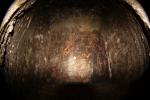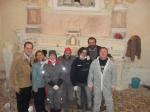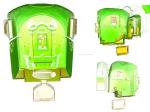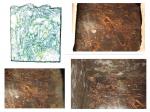Summary (English)
Following research in the archive of the monastery of San Francesco at Follini in Montella (AV), the underground tomb of the Ianelli family was found. The family is attested in the village from the end of the 1500s until 1700. In the years 1614 and 1617 the notary Salvatore Prudente drew up two istrumenti by which the friars undertook to build, at their own expense, a capella sfondata behind the main altar in which to build the choir and an altar to preserve San Francesco’s sack. Sig. Giovanni Berardino Ianelli di Montella undertook to donate a large sum of money for the chapel in return for being buried inside the chapel itself. The underground tomb is in a privileged position in front of the altar “del Sacco”, on a south-east alignment. That this is the tomb of the Ianelli is proved by the presence of a tombstone (57 × 59 cm) closing the chamber bearing the inscription: TVMVLVS IO/A BERARDINI/INNELLI ET EI/VS PROLIS.
The underground chamber was created by excavating the terrain in _ situ_ and isolated by the construction of a rough cobblestone and mortar wall. The holes that housed the beams supporting the centring for the barrel vault were still visible. Twenty-four individuals were found in the chamber, aged between 31/2 – 4years and 60 – 70 years, with an average height of 169 cm for the males and 166 cm for the females. The vast majority of the individuals were male, with two females and one child, probably also male: clearly an indication that burial here was only for the family’s male descendants. The bones were not very well preserved due to the high levels of humidity in the underground chamber, also caused by the presence of wet clay, which in the past caused the west wall to collapse. A calcareous patina caused by the percolation of water and subsequent mineral sedimentation bonded some of the bones belonging to individuals buried below the tombstone. This phenomenon probably occurred through the very fine cracking visible on the north wall through the access trapdoor, and where a stalactite of the same mineral was also present.
The skeletal remains were examined to determine sex, age at death, height, occupational stress and pathologies. The main pathologies identified were tuberculosis, ankylose spondylitis, arthritis, syphilis, DISH, spina bifida and gout. Dental pathologies were also studied and will be collated with the paleo-nutritional analyses. The only artefact found in association with the skeletal remains was a votive medallion, found in correspondence with skeleton no. 16. On one side it shows an image of Sant’ Ignazio di Loyola with an inscription and on the other side an image of S. Francesco Saverio. The medallion is dated post-1623, the year in which the two Jesuits were canonised. The underground chamber was used for burials for about 120 years.
- Simone Schiavone - Università degli Studi “Suor Orsola Benincasa” di Napoli
- Marielva Torino - Università degli Studî Suor Orsola Benincasa Napoli
Director
Team
- Jesper Boldsen - University of Southern Denmark, Odense (Instutute of Forensic Medicine)
- Peter Tarp - University of Southern Denmark, Odense (Instutute of Forensic Medicine)
- Maria Fariello - Soprintendenza Archeologica SA-AV-BN
- Domenico Zangaro - Istituto Geomarine s.r.l
Research Body
- University of Southern Denmark, Odense (Instutute of Forensic Medicine; Istitut for Fysik og Kemi)
- Università degli Studi Suor Orsola Benincasa, Napoli
Funding Body
- Comunità dei frati del Convento San Francesco a Folloni
- Tommaso Jandelli Scorpione





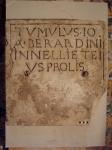
![Download [PDF]](/excavation/skins/fasti/images/results/download_sml.png)
